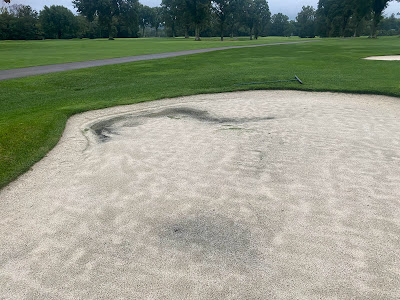Where has the 2022 season gone?! Labor Day is right around the corner and our team is preparing for the last golf events, along with work that will set-up the golf course and grounds for success in 2023.
Recently, many questions have been focused on the inconsistency in the playability of the bunkers, specifically the increased firmness of the sand. Most of the bunkers were renovated in 2004-2005, over the 17 years with rain events the sand has become contaminated with silt, a dark material noted in the pictures below.
 |
| Silt Contamination |
 |
| Gravel Contamination in Sand |
The silt will change the drainage properties of the sand, reducing infiltration rates of excess water, clogging gravel channels below, increasing standing water in the bunkers and ultimately making the sand more difficult to hit from. Each rain event, the silt is removed, and new sand is added, unfortunately this is a short-term fix until the drainage and sand is replaced.
The putting surfaces have held up okay this season, the last break in temperatures from Mother Nature was very helpful. The last couple weeks we have seen some thinning of specific types of bentgrass (Cohansey, Penncross, and others that date back to the 1920’s) the many types of bentgrass are noted in the picture by the different colors and textures.
 |
| Blotchy Appearance of Greens due to Many Types of Bentgrass |
These dated bent grasses are not heat tolerant, cannot be mowed at a low height and are susceptible to many pathogens such as Anthracnose, Summer Patch and Pythium Root Rot. From a playability standpoint, golfers will notice daily changes in smoothness due to stress on the turf (reduction in rolling and other inputs) and the many old varieties that are present on the greens exhibiting different growth rates. We have applied multiple curative fungicides to reduce the thinning turf from Anthracnose. Once the turf thins an Algae mat layer will form, outcompeting the remaining grass for water and nutrients.
 |
| Close-up of Algae Forming where Bentgrass has Thinned. |
The new fescue on 15 hillside is growing in well; a green hue can be seen across this area. It won't be long until we are mowing this area at rough height. The high populations of unwanted grass types in this area offer an opportunity to try various herbicides/strategies (once established) to eliminate both Annual Bluegrass and Creeping Bentgrass. A drop area has been established in the rough near the green (if you choose) or the ball can be hit from the newly seeded area.
Greens Aeration:
September-19th Course Closed/ September-20th/21st Course Open with temporary greens
Thanks for the continued questions and feedback on the golf course and grounds at Hyde Park. Please forward any questions to grounds@hydeparkcc.com
Pat O'Brien
Grounds Superintendent













